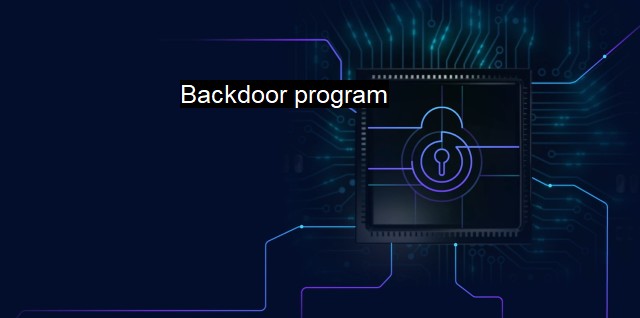What is Backdoor program?
Understanding the Risks of Backdoor Programs: A Closer Look at Their Functioning and Implications for Cybersecurity
"Backdoor program" is a fundamental concept within the realm of cybersecurity and antivirus protection. In the technical lexicon, the term "backdoor" primarily refers to any method devised by an intruder to bypass conventional security mechanisms and gain unauthorized access into a system. a backdoor program is a particular kind of malicious software (malware), crafted to perform such functions and compromising the system's security.A backdoor program employs various techniques to exploit vulnerabilities in a system, connecting the computer to a remote controller, which can then manipulate the system to its advantage, often unnoticed by the user. Predominantly, it leaves the system perpetually accessible for unauthorized attacks from hackers. The damage from these attacks ranges from transferring and altering crucial data, hijacking networks, or engaging in illicit activities using the compromised system.
The origin of backdoor programs traces back to the early days of computing. They were first devised by software developers creating legitimate applications, originally aimed at troubleshooting or providing a means for recovery in the event the primary access delves into issues. But today, they have taken on nefarious connotations, becoming an integral part of the cybersecurity landscape. It serves as a tool used by hackers to infiltrate a network without being detected, dismantle the firewall and security measures, and carry out their unethical operations surreptitiously.
The workings of backdoor programs are covert. After breaching the security measures, they install themselves on the host's system without any conspicuous signs like reduced system performance, pop-up ads, overtly improved network traffic. Unseen and untraced, they covertly blend with the system's legitimate files, reducing the chances of detection even by advanced antivirus programs.
Backdoor programs often come embedded within seemingly harmless software or email attachments. Innocently installed, they find their way into a system, expelling control to external hosts. This is a common cyber-attack strategy known as "trojan horses," where the backdoor programs get their foot inside the wall by posing as another harmless program.
Individuals, corporations, and even government entities have fallen victims to these malicious programs. Private information gets stolen, sensitive data accessed, and leaked, reputational damage caused. Also, backdoor programs might allow its unauthorized individual to turn the system into a "bot," serving as a part of a larger network of systems executing particular acts of harm, such as Distributed Denial of Service (DDoS) attacks.
In terms of safeguarding systems from backdoor programs, ample communication between cybersecurity professionals and regular users is crucial. Open-source software is typically less susceptible to backdoor attacks since they operate on transparent, inclusive principles where anyone can review the program's code. Another precautionary step one could take is to install highly recommended antivirus software with a proven record of detecting and eliminating malicious software before they break into a system.
Since avoiding all email attachments or software downloads aren't feasible, ensuring such links and downloads come from verifiable and trusted sources is critical. Likewise, regular updates of the system's software and operating systems help, as updates incorporate solutions to known vulnerabilities.
The ordeal of backdoor programs is, tragically, a perennial part of our increasing reliance on digital technologies and the internet. While advancements happen in cybersecurity technologies, concurrently, malicious programs and hackers escalate their tactics too. As a result, continuous dialogue, shared knowledge, and coordinated action on backdoor programs and countermeasures bears immense importance in our digital age.

Backdoor program FAQs
What is a backdoor program and how does it work in cybersecurity?
A backdoor program is a type of malware that creates a secret entry point into a computer system. This allows attackers to bypass normal authentication procedures and gain unauthorized access to the system. Once inside, a backdoor program can be used to steal information, launch further attacks, or even take control of the system.How can I protect my computer from backdoor programs?
To protect your computer from backdoor programs, be sure to keep your antivirus software up to date, use strong passwords, and avoid downloading suspicious files or opening suspicious email attachments. It's also important to keep all software and operating systems updated with the latest security patches.What are some signs that my computer might be infected with a backdoor program?
Some signs that your computer might be infected with a backdoor program include slow performance, unusual network activity, unauthorized access attempts, and unexpected changes to system settings or files. You may also notice strange pop-up messages or warning messages from your antivirus software.Can antivirus software detect and remove backdoor programs?
Yes, most reputable antivirus software can detect and remove backdoor programs. However, it's important to make sure your antivirus software is up to date and configured properly to ensure maximum protection. It's also a good idea to run regular scans of your system to detect any potential threats.| | A | | | B | | | C | | | D | | | E | | | F | | | G | | | H | | | I | | | J | | | K | | | L | | | M | |
| | N | | | O | | | P | | | Q | | | R | | | S | | | T | | | U | | | V | | | W | | | X | | | Y | | | Z | |
| | 1 | | | 2 | | | 3 | | | 4 | | | 7 | | | 8 | | |||||||